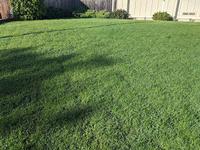Monthly Tip
Lawn Care
Tip description

Make sure you are mowing to a height appropriate for your type of grass. Mow frequently enough so that only one-third of the leaf is removed at any one time. Fertilizing is important, even if you are grasscycling, which only provides about 20% of a lawn's fertilizer needs. Grass is all leaf so the primary nutrient needed is nitrogen. Keep on top of weed removal. Thatch is the layer of living and dead grass material (blades, rhizomes, stolons) that can build up on the surface of the lawn. A thin layer protects the soil surface and shallow roots from drying out from the sun, but a thick layer prevents water from getting through. You can remove dead grass material on the soil surface with a special thatch rake to allows water to reach the roots more easily. More Information: The UC Guide to Healthy Lawns
Months applicable
Category
|






